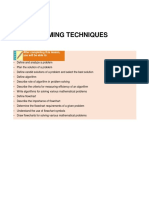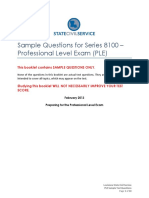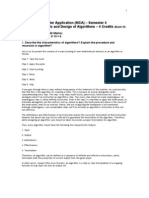9th Class Computer Chapter No. 1
9th Class Computer Chapter No. 1
Uploaded by
Muhammad AsifCopyright:
Available Formats
9th Class Computer Chapter No. 1
9th Class Computer Chapter No. 1
Uploaded by
Muhammad AsifOriginal Title
Copyright
Available Formats
Share this document
Did you find this document useful?
Is this content inappropriate?
Copyright:
Available Formats
9th Class Computer Chapter No. 1
9th Class Computer Chapter No. 1
Uploaded by
Muhammad AsifCopyright:
Available Formats
1
9th Computer Science Chapter No. 1
PROBLEM SOLVING
Q. Define problem.
Ans. A problem is a situation or matter that requires proper attention to be resolved.
Q. What is problem statement?
Ans. A problem statement is a brief description of the problem to be solved. It describes the
problem and identifies its causes and solutions. The problem statement must be prepared
before finding the solution of the problem.
Q. What is problem solving?
Ans. Problem solving is a process of identifying a problem and finding its best solution.
Problem solving •is a thinking process. It is a skill that can be developed by following a well-
organized approach.
Q. Write the names of steps that are involved in problem solving.
Ans. The steps involved in problem solving are defining the problem, analysing the problem,
planning the solution, candid solutions and selecting the best solution.
Q. Why is it important to define a problem?
Ans. A problem cannot be solved if it is not defined correctly. The clearly defined problem
helps the user to find the solution.
Q. List three strategies to define a problem.
Ans. Three strategies to define a problem include gain back knowledge, use gusses and draw
a picture.
Q. Why is it important to gain background knowledge of a problem?
Ans. It is important to understand the situation and circumstances .in whiCh the problem is
occurring. It allows the user to understand the given state. It also helps to know what the
solution will look like and how to measure the solution.
Q. What is problem analysis? Why is it important?
Ans. Problem analysis is a process of understanding the given problem. It is very important
to understand a problem before trying to solve it. A clear understanding of a problem helps
the user to solve it correctly and easily. It also saves money, time and resources.
Q.9. List five Ws to understand a problem.
Ans. The five Ws to understand a problem ate What, Who, Why, When and Where,
Q. What happens in the phase of planning the solution a problem?
For more notes, Guess Papers and Books, visit www.homeofedu.com
2
9th Computer Science Chapter No. 1
Ans. The solution of a problem is planned after defining and analysing the problem. The
problem is assessed to find the right strategy to solve the problem. This phase specifies the
actions required to solve the problem. It also specifies the resources required for the solution.
Q. List different strategies to plan the solution of a problem.
Ans. Different strategies to plan the solution of a problem include divide and conquer; guess,
check and improve; and act it out.
Q. Which strategy divides a complex problem into smaller problems and why?
Ans. The divide and conquer strategy divides a complex problem into smaller problems. The
smaller problems can be solved separately. The process of t-e problem becomes easier. It
also reduces the complexity of the solution.
Q. What is candid solution of a problem?
Ans. The word candid means something unplanned. The candid solution is typically found
using guess without detailed planning. It saves a lot of time but may not be the actual solution
of the problem.
Q. What is flowchart?
Ans. Flowchart is a graphical representation of the solution of a problem. Standard symbols
are used to represent different steps of solution. Different zee used in flowcharts to represent
different operations.
Q. Write any four flowchart symbols.
Ans. The four flowchart symbols include terminal, input/output, process cod flow line.
Q. What is the importance of flowcharts?
Ans. The flowchart is an important tool in problem solving. It can be used to plan the solution
in problem solving. The solution can be understood easily with the help of a flowchart. It also
helps the user to verify if the solution is correct or not.
Q. Write any three advantages of flowchart.
Ans. Flowchart is easy to draw. It helps to understand the easily. It clearly shows the flow
from one step to other.
Q. How is a flowchart constructed?
Ans. A flowchart is constructed by determining different requirements for the given problem.
These requirements include input, processing, decision and output.
Q. How can you show the sequence of the execution of the steps in flowchart?
Ans. The sequence of the execution of the steps in flowchart are shown using the flow lines.
The sequence is generally shown from top to bottom.
Q. Which symbol is used to show processing in flowchart?
For more notes, Guess Papers and Books, visit www.homeofedu.com
3
9th Computer Science Chapter No. 1
Ans. The rectangle is used to represent a processing or computational operation in flowchart.
Q. What is the purpose of parallelogram and rectangle symbol flowchart?
Ans. Parallelogram is used to represent input or output step in the flowchart. Rectangle is
used to represent a processing or computational operation in the flowchart.
Q. Which symbol is used to start and end the flowchart?
Ans. The oval symbol is used to start and end the flowchart. It is also called terminal symbol.
Q.23. What is the use of decision symbol?
Ans. The decision symbol is used to represent decision in flowchart. A condition is given in
the diamond symbol. The flow of control from diamond symbol may go in possible directions.
It goes to one direction if condition is TRUE and to second direction if condition is FALSE.
Q. Define algorithm.
Ans. An algorithm is a finite number of steps to solve a problem. The steps given in the
algorithm are in a specific order. The steps may consist of input, process. decision and output.
Q. Differentiate between flowchart and algorithm.
Ans. Flowchart uses of standard symbols but algorithm uses of simple English. Flowchart is
more time-consuming but algorithm is less time-consuming. Flowchart is difficult to modify
but algorithm is easier to modify.
Q.26. What is the role of algorithm in solving a problem?
An algorithm plays an important role in solving a problem. If is the plan for •solving the
problem. It helps the user to find the solution of the problem. The process of solving a problem
becomes simpler and easier with the help of algorithm.
Q. Is it necessary for an algorithm to solve problem in finite number of steps? If yes, why?
Ans. Yes, it is necessary for an algorithm to solve problem in finite number of steps. The
reason is that the solution of any problem cannot consist of infinite steps. The algorithm has
a clear start and end. The solution is found when all steps are performed in a sequence.
Q. What is the role of input in the efficiency of an algorithm?
Ans. The role of input is very important in the efficiency of an algorithm. An efficient algorithm
must clearly define the required input to solve the problem.
Q. What factors are used to measure the efficiency of an algorithm?
Ans. The efficiency of an algorithm is measured on the basis of number of steps in algorithm
and space -in computer memory. An algorithm is more efficient if it takes less number of steps
to solve a problem. An algorithm is more efficient if it takes less space in computer memory.
Q. What is test data?
For more notes, Guess Papers and Books, visit www.homeofedu.com
4
9th Computer Science Chapter No. 1
Ans. The test data is used to check the correctness of an algorithm. It is important to test the
output of the algorithm after solving a problem. Different values of test data is given to the
algorithm as input. The output is checked to confirm that the algorithm works correctly.
Q. Why testing of a solution important?
Testing is very important to ensure the correctness of the solution. It can be used to find any
errors in the solution. It helps the user to modify and improve the solution. The testing
becomes even more critical if the solution is used commercially.
Q. Differentiate between valid and invalid test data.
A type of test data that is according to the input requirements of an algorithm is called valid
test data. A type of test data that is not according to the input requirements of an algorithm is
called invalid test data.
Q. What is boundary test data?
Ans. The smallest or the largest data values from the range of valid test data is called
boundary test data. An algorithm is tested with the boundary test data to ensure that it handles
these values correctly.
Q. What do you mean by absent data?
Ans. The absent data means that the number of values given to a solution is less than
expected.
Q. What is the process of verification?
Ans. Verification is the process to test if the solution is solving the same problem for which it
was designed. Suppose an algorithm is. prepared to find the percentage of a student and
assign the grade. The user can observe if the algorithm inputs marks and displays grade.
Q.36. What is the process of validation?
Validation is the process to test if the solution is correct or not. Suppose an algorithm is
prepared to find the percentage of a student and assign the grade. The user can check the
output of the algorithm to confirm that the grade is assigned correctly.
Q. What is trace table?
Ans. A trace table is a technique of testing the algorithm to ensure that it does not have any
logical errors. The trace table usually consists of multiple rows and columns. Each column
shows the name of the data element. Each row shows the value of data element in each step.
For more notes, Guess Papers and Books, visit www.homeofedu.com
You might also like
- Setra ManualDocument514 pagesSetra Manualchi100% (1)
- Chapter 1 Computer Science 10 Class Federal BoardDocument23 pagesChapter 1 Computer Science 10 Class Federal BoardAfzal Aslam83% (6)
- Top 30 Data Analytics Interview Questions & AnswersDocument16 pagesTop 30 Data Analytics Interview Questions & Answerskumar kumar100% (1)
- EVM QuestionsDocument9 pagesEVM QuestionsBalaNo ratings yet
- Failure in PVC Pipe ReportDocument6 pagesFailure in PVC Pipe ReportHAJEYY100% (1)
- Dolby Lake Processor System ManualDocument68 pagesDolby Lake Processor System Manualluptei0% (1)
- IFRS 5 Non-Current Assets Held For Sale and Discontinued OperationsDocument12 pagesIFRS 5 Non-Current Assets Held For Sale and Discontinued Operationsanon_419651076No ratings yet
- Chapter No 1 Problem SolvingDocument6 pagesChapter No 1 Problem SolvingSohaibmadniNo ratings yet
- Computer (Unit2 Notes)Document7 pagesComputer (Unit2 Notes)Asifa AkhterNo ratings yet
- Unit 1 Problem SolvingDocument6 pagesUnit 1 Problem SolvingJAMIA QASIMNo ratings yet
- MCS 011Document197 pagesMCS 011Jk LathaNo ratings yet
- UNIT 01 - Introduction To Problem Solving Techniques Using CDocument15 pagesUNIT 01 - Introduction To Problem Solving Techniques Using Clilliangrace1320mhdsNo ratings yet
- Unit 3 Class 7Document2 pagesUnit 3 Class 7Saima SyedNo ratings yet
- 9th Computer 1Document47 pages9th Computer 1Umaira ZafarNo ratings yet
- Problem Solving and Programming ConceptsDocument54 pagesProblem Solving and Programming Conceptssiva100% (1)
- 01 - CSC 201 - AlgorithmsDocument16 pages01 - CSC 201 - AlgorithmsDon JNo ratings yet
- Block 1 PDFDocument55 pagesBlock 1 PDFbhutrotterNo ratings yet
- Unit 1 Problem Solving: StructureDocument197 pagesUnit 1 Problem Solving: StructureShubhashreeBhattacharyaPandaNo ratings yet
- Chemistry Chapter 1 - Part 4Document5 pagesChemistry Chapter 1 - Part 4rgs000No ratings yet
- SRM 1 - UNIT 1 - PM - PPT 4 - Mathematical ModelingDocument32 pagesSRM 1 - UNIT 1 - PM - PPT 4 - Mathematical Modelingthakurhariom86r2No ratings yet
- XM Comp Sci - Ch-1 S-Q AllDocument4 pagesXM Comp Sci - Ch-1 S-Q AllZamirNo ratings yet
- CSC201 Lect1Document13 pagesCSC201 Lect1dixonsilverofficialNo ratings yet
- Algorithmic Thinking and Problem Solving.Test 1docxDocument14 pagesAlgorithmic Thinking and Problem Solving.Test 1docxTariq MahmoodNo ratings yet
- ContinueDocument3 pagesContinueCherry mae LoveteNo ratings yet
- Preparation Guide Diagrammatic Analysis DA INTE SavilleDocument4 pagesPreparation Guide Diagrammatic Analysis DA INTE SavilleJohn StokesNo ratings yet
- Data Science Interview Preparation (#DAY 10)Document11 pagesData Science Interview Preparation (#DAY 10)ARPAN MAITYNo ratings yet
- Problem Solving and Decision MakingDocument65 pagesProblem Solving and Decision Makingbaling_kustriyono100% (1)
- Reporte A3Document5 pagesReporte A3ricatdoNo ratings yet
- Problem Solving MethodsDocument59 pagesProblem Solving MethodsSurendra Gupta100% (2)
- A-Level Revision Notes - 51 Computational MetDocument11 pagesA-Level Revision Notes - 51 Computational MetravskingNo ratings yet
- Algorithm and Flow ChartDocument8 pagesAlgorithm and Flow ChartAhmad ShahbazNo ratings yet
- Unit - Ii: Problem SolvingDocument43 pagesUnit - Ii: Problem Solvingranga231980No ratings yet
- Problem Solving Techniques AND Computer ProgrammingDocument34 pagesProblem Solving Techniques AND Computer ProgrammingAbhiNo ratings yet
- PPS UNIT A (B)Document21 pagesPPS UNIT A (B)jakharshisantNo ratings yet
- ADA Module 1 Part 1Document52 pagesADA Module 1 Part 1rashmi gsNo ratings yet
- Podar Pearl School: Chapter 1: Capstone Project Question and AnswersDocument11 pagesPodar Pearl School: Chapter 1: Capstone Project Question and AnswersAdarsh GopakumarNo ratings yet
- Steven Pascal SDLC G12Document128 pagesSteven Pascal SDLC G12valariesimwanza192No ratings yet
- CMP 211 - Computer ProgrammingDocument49 pagesCMP 211 - Computer Programmingveneraljedexx1No ratings yet
- CSC1302 IPS Lecture NoteDocument60 pagesCSC1302 IPS Lecture Notechrismeshak67No ratings yet
- Computer Science CLASS: 10Document8 pagesComputer Science CLASS: 10AftabTanoliNo ratings yet
- Business Analyst Interview General Questions and AnswersDocument11 pagesBusiness Analyst Interview General Questions and Answersnaveenreddy1No ratings yet
- Assignment PP A01Document22 pagesAssignment PP A01Ramesh ThapaNo ratings yet
- Summary_ Statistical Thinking and Problem SolvingDocument5 pagesSummary_ Statistical Thinking and Problem SolvingAdrian ThrakNo ratings yet
- Six SigmaDocument6 pagesSix SigmaGI JimboyNo ratings yet
- Problem Solving and ReasoningDocument37 pagesProblem Solving and ReasoningJhonz DacuyaNo ratings yet
- 2.1BSA-CY2 - REVERAL, ANGELA R. - EXERCISE#1 - Management ScienceDocument3 pages2.1BSA-CY2 - REVERAL, ANGELA R. - EXERCISE#1 - Management ScienceAngela Ricaplaza ReveralNo ratings yet
- Che514 V01 Notes 1Document9 pagesChe514 V01 Notes 1Ryle ArbonNo ratings yet
- 7 Unit 3 2024Document5 pages7 Unit 3 2024lahorenastaliqNo ratings yet
- Week 1 - Problem Solving PDFDocument17 pagesWeek 1 - Problem Solving PDFAmoi AnthonyNo ratings yet
- CSEGATEDocument138 pagesCSEGATESaritha CeelaNo ratings yet
- CTPC Unit 1 NotesDocument17 pagesCTPC Unit 1 Notespranavhendre07No ratings yet
- Sample Questions For Series 8100 - Professional Level Exam (PLE)Document10 pagesSample Questions For Series 8100 - Professional Level Exam (PLE)Matt H GonzálezNo ratings yet
- Problem Solving and Decision Making Analysis ToolsDocument12 pagesProblem Solving and Decision Making Analysis ToolsHassanNo ratings yet
- CH 5Document10 pagesCH 5Diana JohnNo ratings yet
- Master of Computer Application (MCA) - Semester 4 MC0080 - Analysis and Design of Algorithms - 4 CreditsDocument23 pagesMaster of Computer Application (MCA) - Semester 4 MC0080 - Analysis and Design of Algorithms - 4 CreditsAbhijit KarmakarNo ratings yet
- Lesson Plan1Document3 pagesLesson Plan1jeffrey marapiaNo ratings yet
- Preparation Guide Diagrammatic ReasoningDocument4 pagesPreparation Guide Diagrammatic Reasoningjulita08No ratings yet
- PIC - Module 1 - Part 1Document12 pagesPIC - Module 1 - Part 1ParameshNo ratings yet
- Math 9 - Unit 1 9n3 4 CH 1 2 2Document15 pagesMath 9 - Unit 1 9n3 4 CH 1 2 2api-300773127No ratings yet
- C Programming Sample Questions For Exams and Interviews Useful For Students in Exams and InterviewsDocument185 pagesC Programming Sample Questions For Exams and Interviews Useful For Students in Exams and Interviewsjeethendra7289No ratings yet
- Why Should We Hire You?: Answer: Take This Opportunity To Put Your Strongest Foot Forward. Talk About WhatDocument5 pagesWhy Should We Hire You?: Answer: Take This Opportunity To Put Your Strongest Foot Forward. Talk About WhatSubham PradhanNo ratings yet
- Algorithm and Flow ChartDocument8 pagesAlgorithm and Flow ChartMuhammad SalisNo ratings yet
- Modeling and Analysis by Bowo, Handri and JuvenDocument15 pagesModeling and Analysis by Bowo, Handri and Juvenbho_wooNo ratings yet
- Confident Programmer Problem Solver: Six Steps Programming Students Can Take to Solve Coding ProblemsFrom EverandConfident Programmer Problem Solver: Six Steps Programming Students Can Take to Solve Coding ProblemsNo ratings yet
- Product DataDocument2 pagesProduct DataMuhammad AsifNo ratings yet
- Saes H 201Document15 pagesSaes H 201Muhammad AsifNo ratings yet
- Engineering Standard: SAES-H-200 30 March 2020 Storage, Handling, and Installation of Coated PipesDocument10 pagesEngineering Standard: SAES-H-200 30 March 2020 Storage, Handling, and Installation of Coated PipesMuhammad AsifNo ratings yet
- Inorganic Zinc v1 PDFDocument278 pagesInorganic Zinc v1 PDFMuhammad AsifNo ratings yet
- Guidelines Interline624 CargoTanksDocument27 pagesGuidelines Interline624 CargoTanksMuhammad AsifNo ratings yet
- APP SPEC Galvanize - SSPC SP2Document2 pagesAPP SPEC Galvanize - SSPC SP2Muhammad AsifNo ratings yet
- Terms and Conditions of Carriage enDocument32 pagesTerms and Conditions of Carriage enMuhammad AsifNo ratings yet
- 2 Coating Inspector Muhammad Asif PDFDocument9 pages2 Coating Inspector Muhammad Asif PDFMuhammad Asif0% (1)
- Haradh & Hawiyah Field Gas Compression Project: Batch Wise Coating ReportDocument1 pageHaradh & Hawiyah Field Gas Compression Project: Batch Wise Coating ReportMuhammad AsifNo ratings yet
- Introduction To Data Science With PythonDocument2 pagesIntroduction To Data Science With PythonMuhammad AsifNo ratings yet
- PDFDocument2 pagesPDFMuhammad Asif100% (1)
- BGAS PaperDocument9 pagesBGAS PaperMuhammad AsifNo ratings yet
- Corrosion and Protective CoatingsDocument51 pagesCorrosion and Protective CoatingsMuhammad AsifNo ratings yet
- 2.naima Ci PPT Final PDFDocument14 pages2.naima Ci PPT Final PDFMuhammad AsifNo ratings yet
- PP Japan - UN Women PDFDocument4 pagesPP Japan - UN Women PDFBasia JakubiakNo ratings yet
- Non Leading Ledger Helps in Parallel AccountingDocument6 pagesNon Leading Ledger Helps in Parallel AccountingmonaNo ratings yet
- Ebook Continuous Delivery 2 0 Business Leading Devops Essentials 1St Edition Qiao Liang Online PDF All ChapterDocument69 pagesEbook Continuous Delivery 2 0 Business Leading Devops Essentials 1St Edition Qiao Liang Online PDF All Chapterflorence.vanbuskirk842100% (12)
- Soal Hortatory ExpositionDocument13 pagesSoal Hortatory Expositionladelaprimasta45No ratings yet
- Complete (Ebook PDF) Business in Context: An Introduction To Business and Its Environment, 7th Edition PDF For All ChaptersDocument41 pagesComplete (Ebook PDF) Business in Context: An Introduction To Business and Its Environment, 7th Edition PDF For All Chaptersmahttegharb100% (2)
- Islamic Centers, PhilippinesDocument3 pagesIslamic Centers, Philippinesleoconsolacion100% (1)
- Manual de Instruções Iveco Eurocargo Euro 6Document226 pagesManual de Instruções Iveco Eurocargo Euro 6rsp filmes100% (1)
- Between:: ClaimantsDocument49 pagesBetween:: ClaimantsAR GameCenterNo ratings yet
- Fourth Amendment To The Fourth Local Emergency Directive Related To COVID-19Document2 pagesFourth Amendment To The Fourth Local Emergency Directive Related To COVID-19DavidNo ratings yet
- Market Survey: Kidswear ModuleDocument21 pagesMarket Survey: Kidswear Modulemaggi -No ratings yet
- Combiners and Filters Outdoor Dual Band Combiner 1710-1880 and 1920-2170 MHZDocument1 pageCombiners and Filters Outdoor Dual Band Combiner 1710-1880 and 1920-2170 MHZСерега МазунинNo ratings yet
- Poultry Brolier Business PlanDocument14 pagesPoultry Brolier Business PlanTrinath DasNo ratings yet
- 1-CE-323-Hydrology IntroductionDocument34 pages1-CE-323-Hydrology IntroductionHamza Ahmad QureshiNo ratings yet
- MAHARASHTRA STATE WOMENS COUNCIL ADOPTION GROUP AT MAHARASHTRA Vs KAPIL VISHWANATH JABSHETIDocument9 pagesMAHARASHTRA STATE WOMENS COUNCIL ADOPTION GROUP AT MAHARASHTRA Vs KAPIL VISHWANATH JABSHETIlahop79862No ratings yet
- Ojeda v. OrbetaDocument2 pagesOjeda v. OrbetaElle MichNo ratings yet
- Samiksha Social MediaDocument55 pagesSamiksha Social MediaJayanti PandeNo ratings yet
- Datavideo Product Guide 2015 PDFDocument19 pagesDatavideo Product Guide 2015 PDFDaniel SevillaNo ratings yet
- The Country-Level Income Structure of The World-Economy: Salvatore J. BabonesDocument14 pagesThe Country-Level Income Structure of The World-Economy: Salvatore J. BabonesCallum BromleyNo ratings yet
- Property, Machine and Equipment Valuation Report: Prepared ByDocument19 pagesProperty, Machine and Equipment Valuation Report: Prepared ByKerealem MinyiksewNo ratings yet
- Job Sheet - 3-ArcDocument3 pagesJob Sheet - 3-ArcSamerNo ratings yet
- Hacker Rank Questions KungaDocument25 pagesHacker Rank Questions KungaKunga JamphelNo ratings yet
- Amos Training Module Engineering Training ManualDocument362 pagesAmos Training Module Engineering Training ManualDương Nguyễn HàNo ratings yet
- Hazardous Area ClassificationDocument5 pagesHazardous Area ClassificationS S V Jagannadha Sarma GummaNo ratings yet
- DiMarzio HH Wiring - 2 Humbucker, 3-Way Toggle SwitchDocument1 pageDiMarzio HH Wiring - 2 Humbucker, 3-Way Toggle SwitchJustinNo ratings yet
- Analysis of Internal Environment: Chapter-5Document34 pagesAnalysis of Internal Environment: Chapter-5Farhan Israq AhmedNo ratings yet







































































































